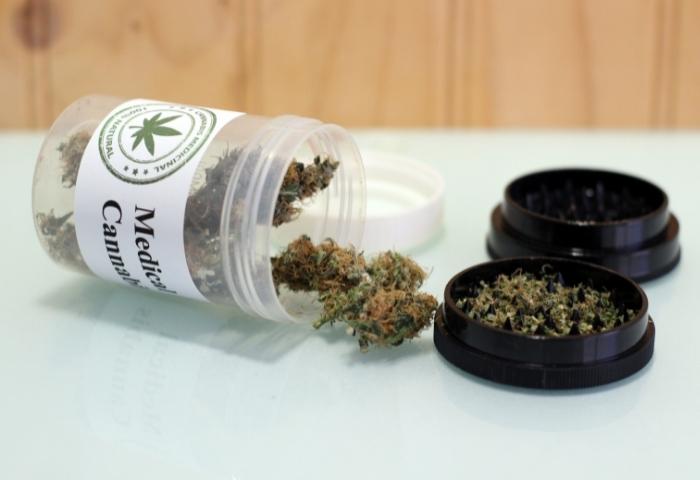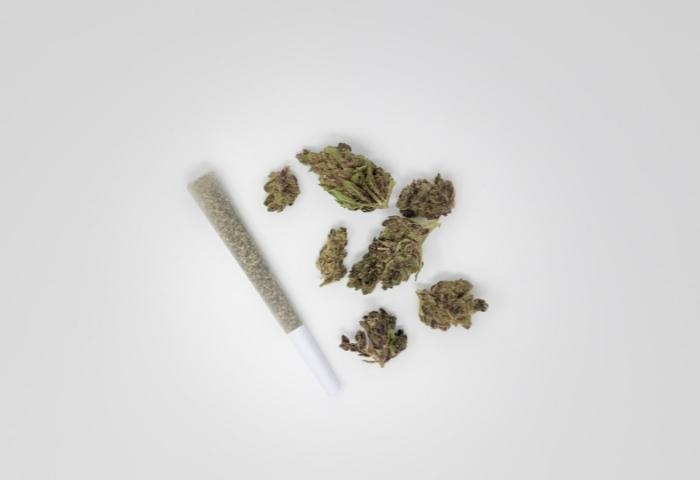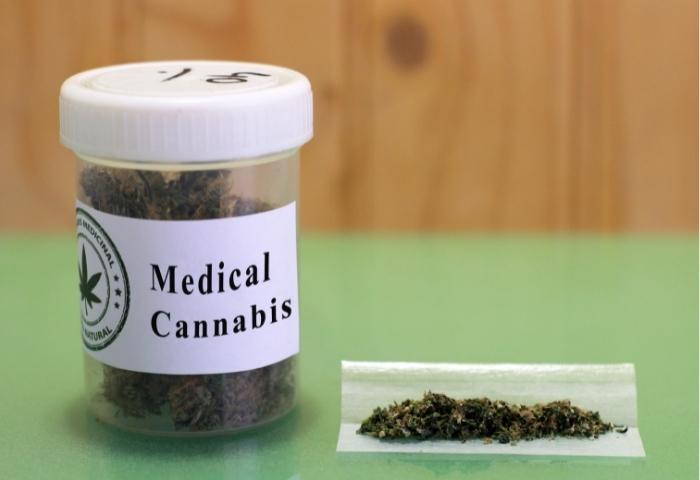In America, the opioid crisis has devastated urban and rural communities, torn apart families, and created a generation of young adults addicted to prescription drugs. One of the only areas that bring hope is decriminalizing recreational and medical marijuana.
A study conducted by researchers from Yale found a direct correlation between the frequency of cannabis dispensaries and opioid overdoses. As the number of dispensaries within walking distance increases, the amount of overdoses decreases.

Studies like this bring hope, but we are still far from understanding how to treat pain patients with medical marijuana. While access is essential, more research is needed to create actionable plans to help cannabis users manage pain.
In this post, we discuss the mechanism that medical marijuana can treat pain, different types of cannabis, and applications to mitigate pain.
How the Endocannabinoid System Can Treat Pain
To understand how cannabis compounds can help with pain, we need to develop a basic understanding of the endocannabinoid system.
The endocannabinoid system or ECS is why cannabis delivers a high and has medicinal properties. This complex network of neurotransmitters, receptors, and enzymes is responsible for relieving pain, affecting our appetite, altering our mood, and helping us sleep.
While the ECS is incredibly diverse, this article will only concentrate on how we deal with pain.
Cannabinoids THC and CBD
There are over 100 known cannabis compounds called cannabinoids. While THC and CBD are the most abundant and well known, many others are emerging into the mainstream thanks to the federal legalization of hemp.
CBG, CBN, and CBC are among the most popular ‘minor cannabinoids,’ and many CBD companies offer them as the dominant compound in their products.
When we introduce cannabinoids to the body, our chemical composition changes. People experiencing chronic pain may feel relief immediately or over time, depending on the chemical composition of the product they are taking and their pain management strategy.
Endocannabinoids
Endocannabinoids are cannabis-like molecules naturally produced by our bodies. People who have an endocannabinoid deficiency could be more susceptible to conditions like depression, sleep disorders, anxiety, and chronic pain.
Using cannabinoids like CBD increases the production of endocannabinoids by inhibiting enzymes that break down the cannabis-like compounds before they can influence our bodies.
Degrading Enzymes
The enzymes that degrade endocannabinoids can be inhibited with consistent CBD use. Taking CBD oil or smoking high CBD strains regularly will lower the efficacy of the enzymes and increase endocannabinoid production.
Cannabinoid Receptors
The final component of the ECS is the most important. Cannabinoid receptors are responsible for releasing chemicals like dopamine and serotonin, altering the chemical composition of our brain.
Cannabis scientists have identified two types of cannabinoid receptors, CB1 and CB2. CB1 is found primarily in the brain and central nervous system, while CB2 exists throughout the body, with significant concentrations in the immune system.
Activating the cannabinoid receptors can be done in two ways. Medical marijuana users who consume large amounts of THC will instantaneously activate the receptors, flooding their brain with dopamine. THC directly binds with CB1 and CB2.
Users who take CBD activate the receptors but in an indirect way. CBD can’t directly bind with CB1 or CB2; instead, regular dosing inhibits the degrading enzymes and produces more endocannabinoids that activate the receptors.
Recreational Vs. Medical Cannabis
The composition of marijuana dramatically affects how the endocannabinoid system responds. If you are looking to mitigate pain with medical marijuana, it is important to understand the different types of cannabis products.
Recreational and medical marijuana differ legally and in the chemical composition of the strain or extract. Cannabis products genetically designed to make the user as high as possible are usually used recreationally, while products with high amounts of CBD are more commonly used for medicinal purposes.
High THC Low CBD
While cannabis products with high concentrations of THC are usually used for recreational purposes, many users suffering from chronic pain find relief in getting high. However, taking high amounts of THC isn’t a sustainable treatment for most people because they cannot deal with everyday tasks while intoxicated.
High CBD Low THC
Most medical marijuana doctors recommend stains or extracts with high amounts of CBD and a low concentration of THC. The cannabinoids are better off working together; this phenomenon is known as the entourage effects. In addition, these products won’t deliver intense highs, and CBD offers a more sustainable path to pain relief.
1:1 THC and CBD Strains
Taking a balanced approach to medical marijuana is growing in popularity. Products with equal parts THC and CBD deliver a high, but it isn’t as intense, and you will also get a substantial dose of CBD.
1:1 offers the best of both worlds, directly activating your cannabinoid receptors and increasing endocannabinoid production for long-term effects.
Cannabinoid Hemp
Cannabis products with under 0.3% THC are considered cannabinoid hemp. Since the passing of the 2018 ‘Farm Bill,’ these types of products have been federally legal in the United States.
Isolate CBD, full-spectrum, and broad-spectrum CBD products have increased massively in popularity now that access is widespread.
While there is evidence to suggest that CBD can help combat pain and the side-effects of pain like anxiety and trouble sleeping, most experts agree that more than 0.3% is needed to experience the full potential of cannabis.

Types of Cannabis
The type of cannabis products you choose also affects the pain receptors in your brain, central nervous system, and around the body. While cannabinoids are the most significant compound in marijuana, terpenes play an essential role in delivering medicinal benefits.
Terpenes like myrcene, linalool, and beta-caryophyllene have pain-relieving and sedating properties that increase the experienced benefits.
Cannabis Indica
Pain-relieving terpenes are usually concentrated higher in cannabis indica strains. One of Israel’s most popular medical marijuana strains has high CBD, low THC, and an unusually high concentration of beta-caryophyllene. The strain was genetically designed for all the compounds to work synergistically to deliver pain-relieving effects.
Indica strains are usually associated with sedating properties. This was once a result of the region the strain came from, but because of so much cross-breeding over hundreds of years, the chemical composition is a much better way to determine indica or sativa.
Cannabis Sativa
Stains with high concentrations of terpenes like limonene and pinene deliver an uplifting effect. While some sativa terpenes also have pain-relieving properties, most people choose indica strains when looking for a strain to combat pain.
Hybrid Strains
Hybrid strains are a mix of both indica and sativa. They are believed not to deliver overwhelming sedating or uplifting effects and keep you feeling balanced.
When choosing a strain for pain relief, we recommend an indica or hybrid. However, if you use cannabis during the day and don’t want to feel tired, sativa may be the answer.
Because there isn’t an exact medical marijuana formula to deliver relief for specific conditions, the best plan is to try different strains and cannabis extracts to see which one works best for you.
State Medical Marijuana Laws
Another critical aspect of medical marijuana is access. In the United States, 36 states allow medical marijuana. However, the laws vary from state to state. Texas’ medical program is far different than more progressive states.
Medical patients in the Lone Star State are only allowed to purchase products with 1% THC and have a specific condition approved by the state to receive a medical card. The amount of THC was doubled from 0.5% to 1% in September of 2021.
In all states with only medical programs, you need approval from a doctor before you have access to medical marijuana. But, again, the process is different in every state, so you will need to find your state’s particular regulations to access cannabis for medicinal use.
Federal Government Policies on Medical Marijuana
While most states have either a medical or recreational marijuana program in place, cannabis containing over 0.3% THC is still illegal on the federal level.
Cannabinoid hemp is legal to purchase, sell, and distribute in all 50 states; however, patients looking for pain relief usually need a higher concentration of THC to experience results.
Using Cannabis Instead of Prescription Drugs
America’s addiction to pain medicine has been decades in the making. While medical marijuana could help overcome the damage done, it’s far from being a viable solution to the opioid epidemic at this point. However, there is reason to believe that medical marijuana could play a role in getting people from taking prescription drugs for pain or lowering their daily intake.
Medical News Today reports, “a research paper from 2016 found that marijuana use for cancer pain led to a 64-percent reduction in opioid use, improved quality of life, and caused fewer medication side effects. It also led to participants using fewer medications.”
Many advocates and researchers for medical marijuana see the drug implemented alongside opioids or other prescription drugs to limit adverse side effects. There is currently a clinical trial going on by the National Institute on Drug Abuse that is looking at the effectiveness of CBD and morphine being used simultaneously. The results are set to be released on December 1, 2022.
How Medical Marijuana Users Relieve Pain
There isn’t a single path medical cannabis users are following. Numerous studies and anecdotal accounts support a THC, CBD, or balanced approach.

Chronic Pain
One of the issues of utilizing cannabis for pain in clinical pharmacology is conducting trials and monitoring a patients’ reaction to pain. Most studies focus on the mechanism of pain relief, measuring swelling, and assessing mobility.
Chronic pain is one of the most challenging types to conduct research. However, it is the most common condition cited by medical marijuana patients.
Reducing inflammation
While inflammation is an essential part of the immune response, too much can cause tremendous discomfort. Therefore, reducing inflammation is possibly CBD’s most significant benefit to many users.
Products like CBD oil and other cannabinoid hemp products are widely available and offer the mechanism to relieve pain and decrease inflammation. A research paper from 2020 describes how CBD can affect the immune response. “They concluded that CB1 receptors are involved in nociceptive pain and that both CB1 and CB2 receptors are involved in inflammatory hypersensitivity. The CB2 receptor worked by inhibiting inflammatory hypersensitivity thereby leading to anti-inflammation.”

Cancer Pain
While there are claims that cannabinoids and terpenes have anti-cancer properties, there isn’t enough evidence to make these types of statements. Reducing the side effects of drugs and some cancer related pain symptoms is an everyday use for medical marijuana.
Cannabis products, especially marijuana edibles, are used frequently by cancer patients to help them eat, sleep, and deal with pain.
Multiple Sclerosis
Using medical cannabis for multiple sclerosis or MS is supported by mixed evidence so far. According to WebMD, “An influential national group of scientific institutions concluded that marijuana, aka cannabis, is proven or highly likely to help ease stiffness and muscle spasms that are common with MS, at least as measured by self-reported symptoms. Some evidence suggests that marijuana or its active compounds, called cannabinoids, may ease sleep problems in some people with MS, fibromyalgia, and certain other medical conditions.”
However, the same article also states that evidence suggests medical marijuana can measurable signs of spasticity, and improved muscle tightness is weak.
Sadly, it’s just too early to make a judgment on many health complications related to pain, and that is why a national institute like the FDA hasn’t approved medical cannabis for more conditions.
How to Use Medical Cannabis
Legalization has opened up demand for new administration methods and dramatic improvements to cannabis production.
Since recreational marijuana has been legalized, the evolution of cannabis genealogy and extraction has created highly potent products. Recently, the industry has shifted toward higher CBD and terpene flower, edibles, and extracts.
Smokable Flower
Smoking cannabis flower allows medical patients to capture the essence of the marijuana plant; however, it isn’t the most efficient or healthy way to consume cannabis.
Even though cannabis strains have advanced exponentially over the past century, concentrates still contain much less waste.
Marijuana Edibles
Edibles deliver a highly concentrated dose without having to inhale hot smoke. Patients practicing pain management or cancer related pain often take edibles.
When you eat THC, the drug metabolizes into a different compound called 11-hydroxy-THC, which is much more potent and has delayed effects.
Cannabis Extracts
Extracting THC from the raw plant creates a highly potent product. Typically extracts like wax, dabs, and shatter have an extremely high THC potency and are produced to generate intense highs. However, the extract industry has recently moved to a full-spectrum approach containing more cannabinoids and terpenes.
CBD concentrates are also gaining popularity thanks to their legal status and widespread access. As a result, the industry has moved from CBD oil, topicals, and edibles to offering a massive selection of concentrates that can be dabbed or vaped. There is evidence suggesting that high doses of CBD can benefit conditions like pain, anxiety, and sleep, but more research is needed.

Research on Medical Marijuana for Pain
While the research we have available is limited, many studies are ongoing. Scientists have established that the mechanism for pain relief is possible through various cannabinoid administrations, but widespread clinical trials on human subjects are desperately needed before we get FDA approval.
A meta-analysis of cannabinoids and pain describes how medical marijuana limits nerve pain.
“The mechanisms of the analgesic effect of cannabinoids include inhibition of the release of neurotransmitters and neuropeptides from presynaptic nerve endings, modulation of postsynaptic neuron excitability, activation of descending inhibitory pain pathways, and reduction of neural inflammation.”
Anecdotal evidence is also abundant. The challenge moving forward is demonstrating that a specific amount of THC and CBD can demonstrate measurable relief in a clinical environment for a condition like back pain.
Pain Management
Cannabis has shown potential to treat pain for decades; however, most pain doctors still aren’t recommending cannabis for pain-related conditions.
Recently the conversation has shifted to using a combination of opioids and cannabis to help mitigate pain. The advantages of taking this approach include:
- Fewer withdrawal symptoms
- Easier transition off prescription drugs
- Limiting side effects
- Lower dependency rates
Pain management is a highly challenging condition to treat. Cannabis could offer an alternative to opioids that lead to further drug use, but we are still far from knowing the solution. More data, clinical trials, and long-term observations are desperately needed before the FDA approves medical marijuana as a solution to fight pain.
Chronic Back Pain
Back pain is an issue that affects millions of Americans. According to a Georgetown study, over 16 million adults experience persistent back pain.
Treatment includes exercise, stretching, surgery, and pain management with prescription drugs. As the 6th most common issue in the US, many opioid users report suffering from back pain.
Medical marijuana could be used as a treatment for back pain. One study reports that 45% of patients observed experienced a “reduction in the intensity of pain within 20 minutes of inhalation.”
Migraine Pain
According to the WHO, migraine pain is experienced by over 30% of adults. In addition, millions of people report having a headache over 15 days out of the year. Migraines can bring severe pain, nausea and vomiting, and sensitivity to light and sound.
Medical marijuana and cannabinoid hemp have been studied as a treatment for migraine pain. While there isn’t concrete evidence, a clinical trial is currently taking place at the UC San Diego Health Clinic funded by the Migraine Research Foundation.
Alison Knigge, a participant in the study who has been suffering from severe pain from migraines, is hopeful that the study will identify alternative treatments. “I am proud and grateful to be part of a study that could lead to more tools in the toolbox for those of us who suffer from migraines,” said Knigge. “It could mean one more option when all other options have not worked. This is truly significant for patients whose lives are disrupted on a regular basis from migraines.”
The participants will be given THC, CBD, a combination of both, or a placebo. Studies like this represent progress and show how our understanding of cannabis compounds has evolved.
Severe Nausea
One of the symptoms of migraine pain is severe nausea. The lead researcher in the UC San Diego study has found that “vaporized cannabis may be more effective for those patients who have nausea or gastrointestinal issues with their migraines.”
People suffering from cancer related pain can also experience severe nausea. Marijuana edibles have shown anecdotal evidence in combating the symptoms of cancer and cancer treatments.
The complexity of the chemical composition of cannabis and various administration methods make clinical trials for issues like back pain and migraines extremely challenging, but it appears that the studies have become more diverse and evolving from utilizing isolated compounds and consumption methods.

Medical Marijuana Looks Promising, but More Research is Needed
While medical marijuana has been legal in California since the 1990s and used for decades to treat pain, most scientific research has been focused on the adverse side effects of marijuana rather than the potential health benefits.
We are far from where we should be regarding our understanding of cannabis, but the future looks bright, especially if you look at the clinical trials taking place in 2022.
If you are experiencing chronic pain, back pain, migraines, or other related conditions, medical marijuana could be a viable solution. Unfortunately, there isn’t an established plan to help pain patients, and access to medical marijuana doctors is limited. You are left to try different products with various cannabinoid potency and observe the effects.

